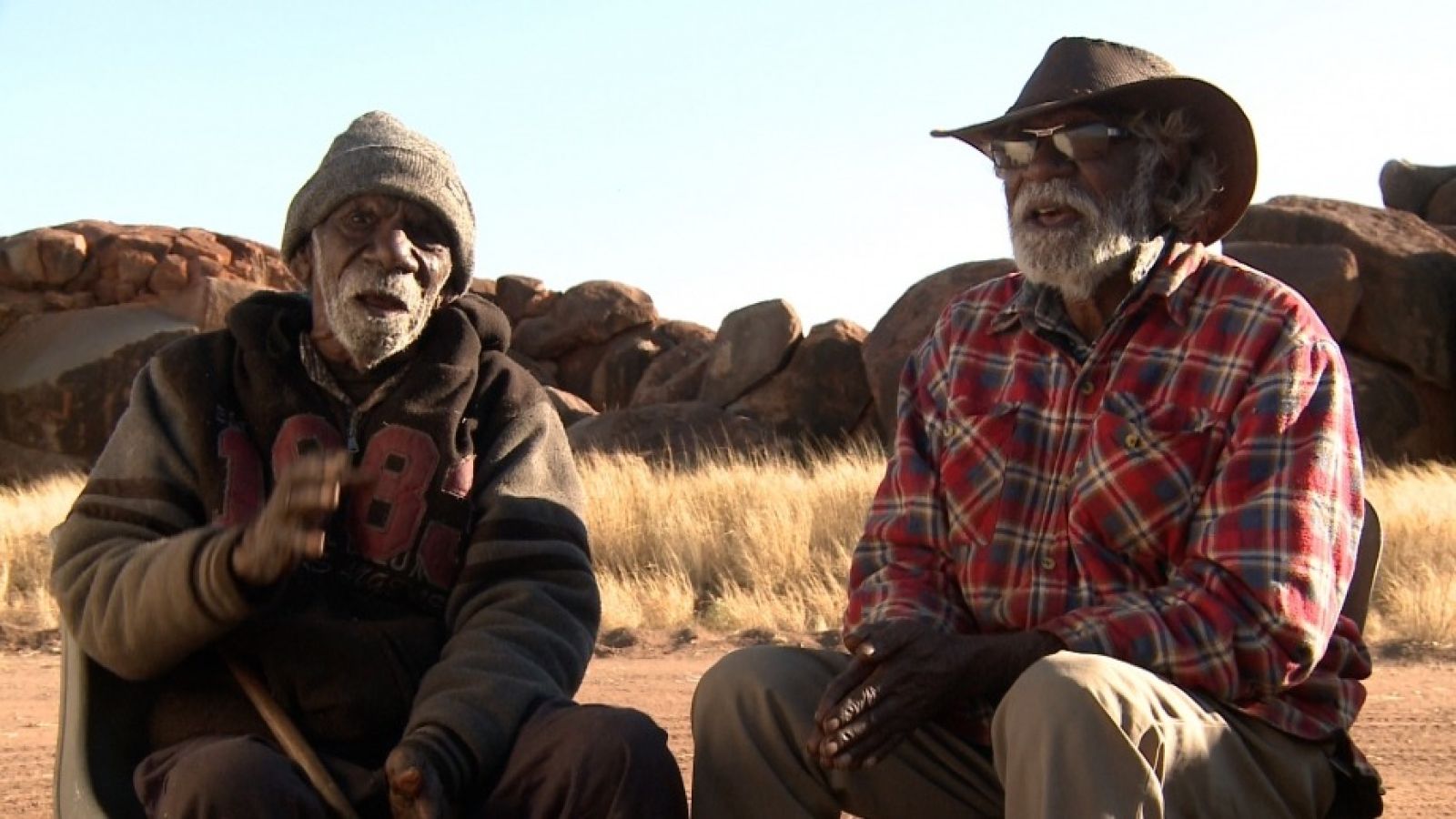From the Bush

Henry Cook Jakamarra and Jerry Patrick Jangala OAM. Image supplied.
ANU linguist Dr Carmel O'Shannessy has spent more than 20 years working in, and researching within, remote Indigenous communities in the Northern Territory. In one of these, Lajamanu, Dr O'Shannessy wound up collaborating with a person she had taught in the 1990s, to make a unique biographical film about the lives of two senior Warlpiri men and the contributions they have made to their community. The men, Jerry Patrick Jangala OAM and Henry Cook Jakamarra, tell the story of their remarkable lives in their own words.
Here, Dr O'Shannessy writes about how the film Kaja-warnu-jangka (From the bush) came about and her experiences making it with her former student, Warlpiri filmmaker Maxwell Walma Japanangka.
Watch Kaja-warnu-jangka online now.
After a chilly morning the sun begins to warm the red earth. A slight breeze stirs the grasses, and people go about their day in Lajamanu Community, to the north of the Tanami Desert. The community is home to about 700 people. Some walk children to school and child care, others go to work at the school, Warnayaka Art Centre, the clinic, the Learning Centre or with the Central Land Council. Maybe some health professionals are visiting the small community from the nearest town of Katherine, 570 kms to the north-east. Other Warlpiri communities lie between Lajamanu and Alice Springs, 873 kms south-east. The road between those is mostly sand and gravel; mobile phones are an asset to communication.
In 1998 I went to Lajamanu to work in the Warlpiri-English bilingual education program in the school, supporting the teaching of Warlpiri language and literacy. I stayed in that position for four years. At that time Maxwell Walma Japanangka, my collaborator on ‘From the Bush’, was about 12 years old! Among others, I worked closely with his mother and her sister, both qualified and experienced teachers; I learned a lot from all of them. The two senior men in the film, Jangala and Jakamarra, were both involved in the school Warlpiri program when we and community elders took the children to specific traditional sites, which can be seen in some of the video and photos in the film. The video of Jakamarra telling a dreaming story to a school group was filmed during one of those trips.
While living in Lajamanu I noticed that children often spoke in a way that mixed Warlpiri with Kriol and/or English, called code-switching, and with the community’s permission I studied the speech of children and young people as a PhD project. It turns out that they had developed a language of their own, a variety of Warlpiri called Light Warlpiri, that is only spoken in this community, and it shows a lot of creativity. It is one of the few languages of this type in the world. Yet they also learn and speak traditional Warlpiri, which continues to be taught in the school.
During my annual visits to Lajamanu, working on Jakamarra’s traditional songs as well as on Light Warlpiri, a few people suggested that someone ought to document the lives of Jakamarra and Jangala, because they have both seen so much change and are highly respected leaders in their community. One of those who suggested it was Minawara Dixon Japangardi, who speaks about Jangala in the film. Both men have contributed a great deal locally and more widely; for instance, Jangala received an Order of Australia medal for his service to his community and the church – he was the main translator of the Warlpiri Bible.
At first I began working towards this book. But progress was slow, and it was difficult to prioritise it along with my academic demands. I knew that Maxwell Walma Japanangka was working with PAW Media and running a radio program, but it was only when we were chatting one day that a way through became clear. Maxwell Japanangka told me that he had just completed a Diploma in Screen and Media from the Batchelor Institute for Indigenous Tertiary Education, and I suggested we collaborate on a film. We obtained funding from Newmont Tanami Operations Pty Ltd, a Local Community Investment program, obtained approval from key people in Lajamanu Community and partnered with PAW Media.
Maxwell Japanangka came to ANU for three weeks and we searched through archives, went to AIATSIS, and he made connections in the ANU School of Art and Design. PAW Media generously allowed us access to their archival video and images, and many people contributed similarly; their names are in the credits. Because of time and budget constraints, a large part of the film comprises existing content – recordings I and others made over several years. Several Warlpiri people helped us with transcribing and translating the Warlpiri recordings; some had done so years earlier. We were able to film Warlpiri community members in Lajamanu, including much of the video of Jangala you can see in the film. On one trip we really battled with the flies and the wind, but with people’s generosity, and the help of some spectacular sunrises, we made it.
It has been an enriching experience to have worked with Jerry Patrick Jangala, Henry Cook Jakamarra, Maxwell Walma Japanangka, their families and the families of Lajamanu, in making ‘From the Bush’. The film captures a little history, a little biography, a little about dreaming stories, and a little about the Warlpiri kinship system and why traditional songs and stories are important. The senior men tell their own stories in their own words, and their stories help shed light on the valuable contributions they have made to their community. Although Lajamanu Community is the primary audience for the film, these stories deserve to be known by the wider Australian community. This might not have happened except through a forum such as this film.
My hope is that we will all learn something from these two men’s remarkable journeys.